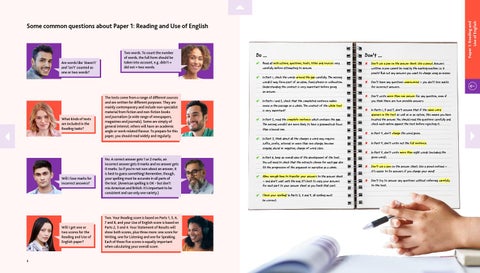Do …
Don’t …
✔ Read all instructions, questions, texts, titles and sources very carefully before attempting to answer.
✘
Don’t use a pen on the answer sheet. Use a pencil. Answers written in pen cannot be read by the marking machine i.e. 0 points! Rub out any answers you want to change using an eraser.
✘
Don’t leave any questions unanswered – you don’t lose marks for incorrect answers.
✘
Don’t write more than one answer for any question, even if you think there are two possible answers.
✘
In Parts 1, 5 and 7, don’t assume that if the same word appears in the text as well as in an option, this means you have located the answer. You should read the questions carefully and check each option against the text before rejecting it.
✘
In Part 4, don’t change the word given.
✘
In Part 4, don’t write out the full sentence.
✘
In Part 4, don’t write more than eight words (including the given word).
fit the progression of the argument or narrative as a whole.
✘
Don’t use a pen on the answer sheet. Use a pencil instead – it’s easier to fix answers if you change your mind!
✔ Allow enough time to transfer your answers to the answer sheet – and don’t wait until the end. It’s best to copy your answers for each part to your answer sheet as you finish that part.
✘
Don’t try to answer any questions without referring carefully to the text.
✔ In Part 1, check the words around the gap carefully. The missing word(s) may form part of an idiom, fixed phrase or collocation. Understanding the context is very important before giving an answer.
What kinds of texts are included in the Reading tasks?
The texts come from a range of different sources and are written for different purposes. They are mainly contemporary and include non-specialist material from fiction and non-fiction books and journalism (a wide range of newspapers, magazines and journals). Some are simply of general interest; others will have an academic angle or work-related flavour. To prepare for this paper, you should read widely and regularly.
✔ In Parts 1 and 2, check that the completed sentence makes sense in the passage as a whole. The context of the whole text is very important! ✔ In Part 2, read the complete sentence which contains the gap. The missing word(s) are more likely to have a grammatical focus than a lexical one. ✔ In Part 3, think about all the changes a word may require: suffix, prefix, internal or more than one change; become singular, plural or negative; change of word class.
Will I lose marks for incorrect answers?
No. A correct answer gets 1 or 2 marks, an incorrect answer gets 0 marks and no answer gets 0 marks. So if you’re not sure about an answer, it is best to guess something! Remember, though, your spelling must be accurate in all parts of the test. (American spelling is OK – but don’t mix American and British. It’s important to be consistent and use only one variety.)
✔ In Part 6, keep an overall idea of the development of the text. You will need to check that the extracts chosen for each gap also
✔ Check your spelling! In Parts 2, 3 and 4, all spelling must be correct.
Will I get one or two scores for the Reading and Use of English paper?
8
Two. Your Reading score is based on Parts 1, 5, 6, 7 and 8, and your Use of English score is based on Parts 2, 3 and 4. Your Statement of Results will show both scores, plus three more: one score for Writing, one for Listening and one for Speaking. Each of these five scores is equally important when calculating your overall score.
Are words like ‘doesn’t’ and ‘isn’t’ counted as one or two words?
Two words. To count the number of words, the full form should be taken into account, e.g. didn’t = did not = two words.
Paper 1: Reading and Use of English
Some common questions about Paper 1: Reading and Use of English





